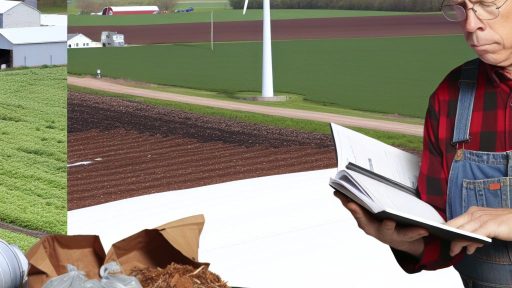Overview of Rural Development Policies and Their Importance for Modern Farming
Rural development policies play a crucial role in modern agriculture.
These policies aim to enhance the quality of life in rural areas.
They focus on improving agricultural productivity and sustainability.
Furthermore, such policies often promote economic diversification.
This diversification allows farmers to explore new income opportunities.
The Role of Government in Rural Development
Government involvement is essential in shaping effective rural policies.
Supportive legislation helps create a favorable environment for farmers.
For instance, grants and subsidies can ease financial burdens.
Additionally, training programs enhance farmers’ skills and knowledge.
This collective effort contributes to stronger rural economies.
Strategies to Support Modern Farmers
Rural development policies employ various strategies for farmer support.
Investment in technology is one key area of focus.
Farmers gain access to advanced tools, boosting efficiency and production.
Moreover, infrastructure improvements facilitate better market access.
Roads and transportation networks play a pivotal role in this aspect.
Transform Your Agribusiness
Unlock your farm's potential with expert advice tailored to your needs. Get actionable steps that drive real results.
Get StartedThe Benefits of Sustainable Practices
Modern rural policies emphasize sustainability and environmental responsibility.
These practices lead to long-term viability for farming operations.
Farmers adopting sustainable methods often experience increased resilience.
In addition, there is a growing market demand for eco-friendly products.
This shift presents new opportunities for revenue generation.
Community Involvement and Local Organizations
Community engagement is vital for successful rural development policies.
Local organizations can support farmers through education and advocacy.
These groups often reflect the unique needs of their communities.
By collaborating with farmers, they can tailor initiatives effectively.
As a result, farmers feel more empowered and supported.
Assessment of Current Rural Development Policies Impacting Farmers
Understanding Existing Policies
Rural development policies aim to stimulate growth in agricultural regions.
These policies provide crucial support to farmers across various sectors.
The government implements programs that offer financial assistance for infrastructure.
Also, they promote sustainable farming practices that enhance productivity.
Moreover, these initiatives help farmers adapt to changing market demands.
Impact on Smallholder Farmers
Smallholder farmers often face unique challenges in rural areas.
Current policies aim to bridge the gap between smallholders and large agribusinesses.
Support programs offer technical training and advisory services.
This assistance empowers small farmers to increase their yields effectively.
Furthermore, improved access to markets enhances their income potential.
Role of Technology in Support Programs
Modern farming increasingly relies on technology and innovation.
Rural development policies now integrate technological advancements.
These include access to precision agriculture tools and data analytics.
Technology enhances operational efficiency and crop management.
Showcase Your Farming Business
Publish your professional farming services profile on our blog for a one-time fee of $200 and reach a dedicated audience of farmers and agribusiness owners.
Publish Your ProfileConsequently, farmers who embrace technology benefit from higher productivity.
Challenges in Implementation
Despite these policies, challenges remain in effective implementation.
Many farmers face bureaucratic hurdles when accessing support.
Additionally, awareness of available programs varies significantly.
Some regions lack the resources to fully utilize government assistance.
Thus, targeted outreach and education are essential for improvement.
Future Directions for Policy Development
Future policies should focus on inclusivity and sustainability.
Addressing the needs of diverse farmer demographics is crucial.
Incorporating feedback from farmers can guide effective policy formation.
Moreover, partnerships with local organizations can enhance program reach.
This approach ensures that rural development policies are relevant and impactful.
Financial Assistance Programs
Types of Financial Assistance
Farmers often rely on various forms of financial assistance.
These programs include grants, loans, and subsidies.
Grants provide direct funding without the requirement of repayment.
Loans, on the other hand, need to be paid back over time.
Subsidies help reduce the cost of inputs for farming operations.
Grants Available for Farmers
Several organizations offer grants specifically for farmers.
The USDA Agricultural Resource Service provides various grants.
State-level agencies also frequently have their own grant programs.
Additionally, nonprofit organizations focus on agricultural development.
These grants often support sustainable practices and innovation.
Loan Programs for Farmers
Loan programs are essential for financing farm operations.
The USDA offers direct loans to eligible farmers.
Farm Credit System provides loans tailored for agricultural needs.
Traditional banks may also have agricultural loan products.
Interest rates vary based on the lender and the borrower’s credit.
Subsidy Programs and Policies
Subsidies play a significant role in stabilizing farmhouse incomes.
Many U.S. farmers benefit from commodity price support programs.
These subsidies help manage market fluctuations and crop prices.
Insurance programs also provide financial backing during crop failures.
Farmers must stay informed about the latest subsidy options.
Eligibility Requirements
Each financial assistance program has its eligibility criteria.
Farmers often must prove operational viability to qualify.
Documenting historical farm income can facilitate applications.
Local agricultural offices provide guidance on qualification.
It’s essential to consult program guidelines carefully.
You Might Also Like: Impact of Farm-To-Table Regulations on Local Agriculture and Farmers
Sustainable Agriculture Practices Encouraged by Government Policies
Incentives for Eco-Friendly Farming
Governments globally offer incentives to encourage sustainable farming practices.
These incentives often come in the form of financial aid, tax breaks, or grants.
Farmers can utilize these funds to invest in eco-friendly technologies.
Showcase Your Farming Business
Publish your professional farming services profile on our blog for a one-time fee of $200 and reach a dedicated audience of farmers and agribusiness owners.
Publish Your ProfileMoreover, these policies promote the use of renewable energy sources in agriculture.
Support for Organic Farming
Many governmental policies now focus on supporting organic farming methods.
Organic farming helps improve soil health and reduce chemical usage.
Additionally, governments provide training for farmers interested in organic certifications.
Such certifications enhance market access and consumer trust.
Promotion of Crop Diversification
Crop diversification is a key practice encouraged by rural development policies.
This method minimizes the risk of crop failure and boosts resilience against pests.
Furthermore, diversified crops improve soil health and increase biodiversity.
Policies often include workshops to educate farmers on best diversification practices.
Water Conservation Techniques
Water scarcity is a pressing issue affecting farmers worldwide.
To address this, many governments promote water conservation practices.
Farmers receive guidance on efficient irrigation methods and rainwater harvesting.
These techniques not only save water but also reduce costs over time.
Research and Development Support
Funding for agricultural research is crucial for sustainable practices.
Governments often collaborate with universities for agricultural innovation.
This collaboration leads to the development of new, sustainable farming technologies.
Farmers benefit directly from research that addresses their challenges.
Gain More Insights: Conservation Programs Enhancing Soil Health On Farms
The Role of Technology in Enhancing Rural Development for Farmers
Introduction to Technology’s Impact
Technology significantly transforms rural development for farmers.
This transformation enhances productivity and sustainability.
Moreover, technology adoption fosters innovation in agriculture.
Improving Farming Practices
Farmers utilize precision agriculture tools for better yields.
These tools enable accurate planting and resource management.
For instance, drones assist in monitoring crop health effectively.
Such advancements lead to reduced waste and input costs.
Access to Information and Resources
Technology provides farmers with valuable information quickly.
Online platforms offer insights into market trends and weather forecasts.
Farmers can access innovative farming techniques through mobile apps.
This access empowers them to make informed decisions.
Enhancing Supply Chain Efficiency
Technological solutions streamline the agricultural supply chain.
Farmers can track their products from farm to market seamlessly.
Blockchain technology ensures transparency and traceability.
Such advancements build trust with consumers and partners alike.
Financial Inclusion and Support
Technology promotes financial inclusion for rural farmers.
Digital payment systems facilitate quick and secure transactions.
Access to online credit platforms helps farmers invest in their operations.
Furthermore, farmers can easily apply for government grants through digital channels.
Fostering Community Connections
Technology helps farmers connect with one another effectively.
Online forums enable sharing knowledge and experiences.
These connections create a supportive community for problem-solving.
Showcase Your Farming Business
Publish your professional farming services profile on our blog for a one-time fee of $200 and reach a dedicated audience of farmers and agribusiness owners.
Publish Your ProfileMoreover, social media platforms raise awareness about rural issues.
Implications of Advancing Agricultural Technology
Ultimately, technology plays a critical role in rural development.
Farmers’ productivity and quality of life improve significantly.
Investing in technology is essential for a sustainable agricultural future.
Uncover the Details: Maximizing Farm Profits Through Understanding Trade Agreements

Community Engagement and Capacity Building Initiatives for Local Farmers
Importance of Community Engagement
Community engagement empowers farmers to take charge of their farming practices.
It fosters a sense of ownership and responsibility among local stakeholders.
Moreover, it creates networks that enhance knowledge sharing and collaboration.
Strategies for Effective Engagement
Implementing workshops helps educate farmers on best practices and new technologies.
Regular community forums provide a platform for open discussions on local needs.
Additionally, farm visits increase awareness of challenges and opportunities in agriculture.
By organizing mentorship programs, experienced farmers can guide newcomers effectively.
Building Capacity through Training Initiatives
Training initiatives are essential for farming success in rural areas.
They equip farmers with the skills needed for modern agricultural techniques.
Furthermore, they improve business management skills among local farmers.
Partnerships with Local Organizations
Establishing partnerships with local organizations strengthens capacity-building efforts.
These collaborations enhance resource availability for farmers.
Local organizations often provide valuable expertise and support options.
Leveraging Technology for Collaboration
Utilizing technology facilitates better communication among farmers and organizations.
Online platforms can host webinars and virtual training sessions.
Mobile apps can connect farmers to market opportunities and information swiftly.
Celebrating Success Stories
Highlighting successful farming initiatives encourages community participation.
Sharing testimonials from local farmers inspires others to join programs.
Public recognition enhances motivation and community engagement.
You Might Also Like: How to Stay Updated with Food Safety Regulations for Farming
Case Studies: Successful Rural Development Policies in Different Regions
North America: Agricultural Innovations
In North America, policies focus on innovation in farming techniques.
The government supports the adoption of precision agriculture technologies.
These innovations enhance efficiency and reduce resource waste.
Farmers also benefit from grants for sustainable practices.
For instance, the Sustainable Agriculture Research and Education program offers funding.
Europe: Cooperative Farming Models
European countries have embraced cooperative farming models.
These cooperatives allow farmers to share resources and knowledge.
This structure improves market access and bargaining power.
The EU provides financial assistance to strengthen these cooperatives.
Such policies have led to increased productivity and farmer income.
Asia: Diversification Strategies
In Asia, rural development policies promote agricultural diversification.
Farmers are encouraged to grow a variety of crops.
Diversification reduces risks associated with market fluctuations.
Governments provide training on new cropping techniques.
For instance, farmers in India benefit from the Pradhan Mantri Krishi Sinchai Yojana.
Showcase Your Farming Business
Publish your professional farming services profile on our blog for a one-time fee of $200 and reach a dedicated audience of farmers and agribusiness owners.
Publish Your ProfileAfrica: Access to Markets and Technology
African countries focus on improving farmers’ access to markets.
Strategies include investment in rural infrastructure, such as roads.
Mobile technology plays a crucial role in this process.
Farmers receive real-time price information, enhancing decision-making.
Additionally, organizations like the International Fund for Agricultural Development support these initiatives.
Latin America: Climate Resilience Initiatives
In Latin America, rural policies emphasize climate resilience.
Programs encourage sustainable land use and conservation practices.
Farmers adopt agroecological practices to combat climate change.
The region has seen the benefits of such policies in recent years.
Collaborative research initiatives help disseminate knowledge effectively.
Future Directions: Recommendations for Policy Improvements Benefiting Modern Farmers
Enhancing Financial Support
Policy improvements can enhance financial support for modern farmers.
Increased access to low-interest loans can empower farmers to invest in technology.
Furthermore, grants for sustainable practices will encourage environmentally friendly methods.
Subsidies for crop insurance can provide a safety net during adverse conditions.
Improving Infrastructure
Investments in rural infrastructure are crucial for modern farming success.
Better roads will facilitate transport of goods to markets quickly.
Upgraded internet connectivity enables farmers to access vital information and resources.
Access to reliable water sources will support crop irrigation and livestock needs.
Encouraging Research and Development
Support for agricultural research fosters innovative practices.
Collaborations between universities and local farms can enhance knowledge-sharing.
Additionally, funding for research on pest-resistant crops can benefit sustainability.
Incorporating farmer feedback into research ensures relevance to current challenges.
Fostering Community Engagement
Encouraging community involvement enhances farmer support networks.
Regular workshops can help farmers share best practices and experiences.
Creating local cooperatives will strengthen farmers’ market positions.
Engagement with local governments can amplify farmers’ voices in policy-making.
Promoting Sustainable Practices
Policies should promote sustainable farming methods for long-term benefits.
Incentives for organic farming will reduce chemical usage and improve health outcomes.
Support for agroforestry can enhance biodiversity and soil health.
Encouraging crop rotation prevents soil depletion and maintains productivity.
Streamlining Regulatory Processes
Simplifying regulations will ease the burden on modern farmers.
Streamlined permit processes can accelerate the adoption of new technologies.
Reducing paperwork associated with grants will encourage participation.
Clear guidelines will help farmers comply with environmental standards effectively.




